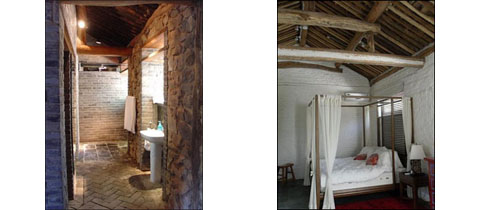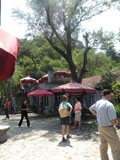Courtesy of Lindsey Dawson.
 Do you think of huge, bustling Beijing as a city with eco lodges at its doorstep?
Do you think of huge, bustling Beijing as a city with eco lodges at its doorstep?
Me neither. But tucked close to the Great Wall of China at a village called Mutianyu is just such a place.
I stumbled over it when we stopped for lunch at its very pleasant café. Built into a walled courtyard alongside an old schoolhouse, it’s in a leafy valley, has umbrella-shaded tables, a very good menu and well-chilled Yanjing beer, a lager that’s fresh and light and hits the spot on a hot day.
Mutianyu is one of a range of places where tourists can get up on the Great Wall close to Beijing.
It’s a must-see, for at nearly 7000 kilometres in length it’s one of the world’s wonders. Started around 200BC, much of it is now crumbling away. The sections we spot most often – the ones where foreign leaders are always taken for a stroll in front of TV cameras – were built during the Ming Dynasty about 600 years ago.
A two-hour drive out of the city, Mutianyu is an extra-good place for a wall visit because it has a chairlift that takes you to the top of the mighty stone barrier in a few short minutes, and a long winding luge to ride on the way down, should you so desire.
Stroll along the wall’s winding top and you’re stunned by the effort it must have taken to build this mighty stone buttress that bisects China from east to west. We were lucky to be there on a fine day and could climb up into watchtowers where soldiers must once have shivered in winter and fried in summer. At one time a million men guarded this stretch of the wall 
As your eye travels along the ridges and peaks of the hills that run off to right and left, the endless line of stone and brick disappears into the haze. Find more history here: www.greatwall-of-china.com.
It’s estimated that 2-3 million died in the centuries it took to build the entire structure. So many bodies were buried there that some call it the longest tomb in the world, but there’s no sadness on a summer day.
We strolled, marveled, snapped pictures – and then got hot and hungry and headed for The Schoolhouse. It was just down the hill on the way to the motorway that would take us back to Beijing.
I ordered up local grilled trout with greens, yum! That the menu blends western and Asian tastes is not surprising as the development is the brainchild of two couples who are both Chinese and American.
They saw how village life was dying. Rural China is doing it hard these days. Young people don’t stay in traditional villages when cities offer better money; factory workers can now earn in a month what an acre of rural land can yield in a year.
Add to that talent drain the one-child family policy and there are fewer children around. The Mutianyu primary school had closed down and old people were having to get by on their own. . 
The foursome – Jim Spear and Liang Tang, and Julie Upton-Wang and Peiming Wang – used to holiday in the area. The local mayor asked if they could help. They saw the school’s potential, took it over the buildings and have set up a dining and lodging business that’s won a raft of tourism awards.
It’s all very ‘green’, using local produce, working sustainably and providing new local jobs so that village life can be maintained; some of their kitchen staff are local housewives who’d never had a job before.
The multi-layered complex also has a glass-blowing studio and smithy, a retreat centre made from an old glazed-tile factory and a resort comprising a scatter of abandoned ancient houses that have been upgraded as getaway luxury retreats for jaded city types. On the run that day, we didn’t get a look inside one of those. Back home, I can only drift around the website and dream… www.theschoolhouseatmutianyu.com.
Air New Zealand flies direct to Shanghai five times weekly.
For further information and to book visit www.airnewzealand.co.nz
By Lindsey Dawson










Join the Discussion
Type out your comment here:
You must be logged in to post a comment.